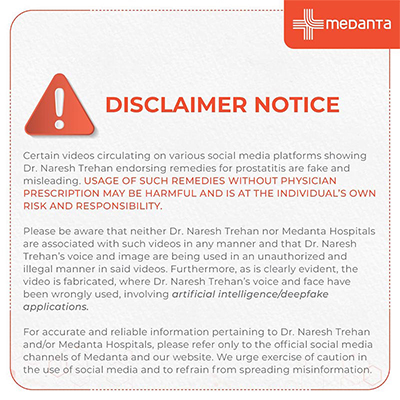
Sacral Nerve Stimulation for Neurogenic Bladder
Losing control over one’s ability to urinate can be emotionally and socially devastating. This was the circumstance of a 54-year-old male who presented to Medanta-Gurugram. He was unable to pass urine due to advanced spinal arachnoiditis-induced neurogenic bladder. The patient had been suffering from a neurogenic bladder for more than five years and had not experienced any significant relief or improvement from the medications, pelvic exercises and behavioral therapy. His quality of life was severely impacted and punctuated by suicidal thoughts.
The patient underwent thorough clinico-radiological evaluation. Thereafter, he was advised an ingenuous neuro-modulation therapy known as Sacral Nerve Stimulation (SNS) to correct his urinary malfunction.
SNS is a neuromodulation therapy of the sacral nerves to modulate the reflexes that influence the urinary bladder, sphincter and pelvic floor. It acts like a pacemaker and utilizes mild electrical pulses to improve or restore normal voiding function. It is indicated for patients suffering from neurogenic bladder due to a plethora of neurological, urological and/or gynaecological causes, who have failed or did not respond to conservative therapy, such as medications, behavioural therapy, and pelvic exercises. Up to 30%-50% of all neurogenic bladder patients are non-responsive to conservative therapy. Additionally, more than 90% patients who initially respond to conservative treatment become non-compliant in about 24 months. In all such patients, SNS therapy is being seen as an effective solution.
SNS therapy works for urinary urgency-frequency, incontinence and non-obstructive retention. The mechanism of action is multifactorial; it is hypothesized that sacral nerve stimulation works via modulation of spinal and supra-spinal reflexes through afferent signaling rather than direct motor stimulation.
There is an initial trial period to assess the viability of SNS therapy. During the trial procedure performed under local anasthesia, the right S3 nerve (preferable nerve of choice) is negotiated through the appropriate sacral foramen under fluoroscopic guidance and stimulated for appropriate motor and sensory reponses, confirming which the SNS electrode is implanted and secured to an external stimulation system for next 3-7 days. Only those patients who experience at least 50% improvement in their symptoms, during the trial period, are given a final SNS implantation.
During the trial period, our 54-year-old male patient experienced an improvement of more than 70% in his symptom of urinary retention caused by a neurogenic bladder with more than 90% reduction in the volume of post-void residual urine in the urinary bladder as assessed by ultrasound of kidneys, ureters, and urinary bladder (KUB). Subsequently, he underwent implantation of a permanent SNS pulse generator system as the next step.
The procedure went well with good clinical outcome. Patient was discharged on Day 3 of the procedure and is doing well just like other satisfied patients who have previously undergone this surgery at Medanta.






